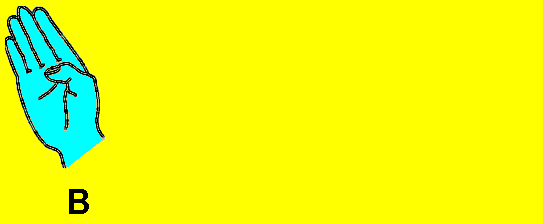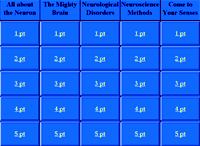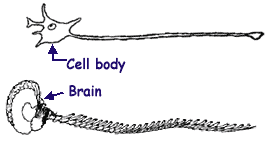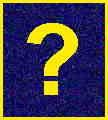Neuroscience For Kids
Brain Games
Many of the games listed below have separate pages...just click on the small picture of the game to open up a new page to play.


Colors, Colors?
Grades K-12
The Stroop Effect: How do words influence what we see (or say we see)?
On-line Brain Jigsaw Puzzles
Grades K-12
Scramble these puzzles and see if you can put them back together...all ON-LINE!

Neuro-Jeopardy
Grades 5-12
Welcome to NEURO-JEOPARDY!
Neuro-Jeopardy is a game to test your knowledge about the nervous system. The game is contained in a Powerpoint file. Therefore, your computer must have the ability to read ppt files. A Spanish version of the game is also available.
Brain Hieroglyphics
Grades K-12
Your job here is to read pictures to make a single word or phrase. Each word or phrase has something to do with the nervous system. For example:
 This one is read as: brain.
This one is read as: brain.
Here are some more Brain Hieroglyphics

Sam's Brainy Adventure
Grades K-6
An on-line comic book describing Sam's incredible journey into his own brain.
Brain Alphabet
Grades K-12
Spell your name with "brainy" letters using the Brain Alphabet.
![]()



On-line Response Time Experiments
Grades K-12
How fast are you? Test your response time using these reaction time experiments.
Experiment 1 - Start/Stop test
Experiment 2 - Stoplight test
Experiment 3 - Hit-the-dot test
Experiment 4 - Color test
Experiment 5 - Check box test
Neuroscience Coloring Books

Grades K-12
Now there are THREE ways to color:
- Print out single pages and color by hand.
- Print out a 10 page coloring book (PDF format) and color by hand.
Color ON-LINE
The Brain Game
Grades K-6
Roll the die, move your Brain Marker and follow the directions on the space. If you are the first to collect 20 neurons, you are the winner!
Materials:
Brains and Neurons Board Game

Grades K-6
If you have played the game called "Shoots and Ladders," then you know how to play "Brains and Neurons."
How to play:

- The first player rolls a die (or use two dice for a faster game) and moves his or her marker to the space shown on the die.
- If a player's marker lands on the cell body of a neuron, the player can move forward to the space at the end of the neuron. If a player's marker lands on a brain, the player must move down to the space at the end of the spinal column.
- The first player to space #100 is the winner.
Materials:
- Game Board
- Dice or make your own dice.
- Markers (pebbles, coins, caps, seeds, etc.)
Brain It!
Grades K-6
"Brain It!" is a card game similar to "Go Fish." How to play:
- Print out ONE copy of these Brain Cards or two copies of these Brain Cards. The first set of cards is a traditional set of 52 playing cards with pictures of different brains. The second set has 24 pictures of different brains. If you use the second set of cards and print out two copies, you will have 48 cards.
- Cut out each picture along the lines to make small cards.
- Brain It! is best played with 2 to 5 players. Mix up the brain cards. Give each player five brain cards. The remaining cards should go into a pile. The object of the game is to make matches of the same brain, for example, elephant brains. Players take turns asking other players for brain cards to complete their matches. The player who asks for a card must already have at least one card of the type requested. If the player who was asked has a brain card of the type requested, he or she must give this card or cards to the player who asked. The player that gets a card or cards can ask again.
- If a player does not have the card requested, then the player who asked for the card must "Brain It!" and take a card from the pile. If the card drawn from the pile is the same as the card the player asked for, then that player gets another turn. If the card is different from the one asked for, then it is the next person's turn.
- When a player collects matches of the same brain, these cards are placed face up in front of the player. The game is over when all of the cards are drawn. If a player runs out of cards, then one can be taken from the pile. The player with the most matches is the winner.
Materials:
- Brain Cards - set 1 (print one copy)
- Brain Cards - set 2 (print two copies)
You can also play Brain It! with this set of 52 Neuroscience Playing Cards
.On-line Short Term Memory Game
Grades K-12
Think you have a good memory? Then take this little Short Term Memory Test
Face Recognition Game
Grades 3-12
How easy is it to recognize faces when they are upside down? Find out with this face recognition game.
Crossword Puzzles
 Printable Puzzles
Printable Puzzles
Word Search Games

Grades 3-12
Find the hidden words.
| Printable Worksheets |
Brain Facts that make you go, "Hmmmmm".
Grades 6-12
Pass the box around and read a fact. These facts just might make you say, "Hmmmmmm".

Neuroscience Treasure Hunt
Search the web for answers to questions about the brain and nervous system -- win the GOLDEN NEURON AWARD!!

The "Sea of Neurons"
Grades K-6
Find the unipolar cell in this "Sea of Multipolar Neurons" using this puzzle.

Brain Bingo Game
Grades 3-8
Play the classic "3 in a row" game with neuroscience words.

Brain Trip
Grades K-6
Flip a coin and move from brain to brain in this board game.

Brain Board Game
Grades K-8
It may not be the game of "Monopoly" or "Candyland", but this brain board game may be a fun way to learn the names of parts of the brain and parts of a neuron.
Neuron Race Board Game
Grades 3-8
Race to send your signal faster than your opponents! This game was created by Seth Eggleston, Veronica Hoelscher, and Malayka Mottarella at Willamette University.
Get instructions and game board.

Brain Tic Tac Toe
Grades 5-9
Guess what the pictures in the 3 rows, 3 columns and 2 diagonals have in common in this puzzle.

Brain Concentration Game
Grades K-6
Test your memory using this classic card game. Cut out the pieces and play CONCENTRATION
On-line Concentration Games
Grades K-12
 Test your memory with
this on-line concentration game by locating the
matching brains of different animals. The game requires that your
browser is "JAVA-enabled."
Test your memory with
this on-line concentration game by locating the
matching brains of different animals. The game requires that your
browser is "JAVA-enabled."
 Test your memory with this on-line
concentration game by locating the pictures of different sense organs
(ear, eye, nose, skin, tongue). The game requires that your browser is
"JAVA-enabled."
Test your memory with this on-line
concentration game by locating the pictures of different sense organs
(ear, eye, nose, skin, tongue). The game requires that your browser is
"JAVA-enabled."
The Memory Game
Grades 3-12
See how good your memory is...I will present you with a set of 20 pictures for 30 seconds. The pictures will disappear automatically after 30 seconds. Then write down the names of all the objects you can remember.
For ways to improve your memory, look at the Memory Page

Same/Different Puzzle
Grades K-3
This puzzle challenges you to find the 2 neurons that look exactly the same.

Make Sense!
Grades K-6
Can you make sense of this puzzle? Draw lines to match pictures and words.

Lost Connections
For Grades K-3
Help these Lost Neurons find their connections.
Brain Bowl
Grades 7-12
To play: Questions are prepared either by the students or the teacher. The teacher then asks a question to the class as a whole or to teams of players. Each correct answer is scored as 1 point. Player or team with the most points is the winner.
Here is a list of potential categories and questions to get you started:
Vision
- What lobe of the brain processes visual information?
Answer: Occipital Lobe - What is the name of the retinal receptor responsible for color
vision?
Answer: Cone
Anatomy and Physiology of the Brain
- What are the grooves on the brain surface
called?
Answer: Sulci - How many cranial nerves are there?
Answer: 12 - What cranial nerve carries information from the teeth to the brain?
Answer: The trigeminal nerve - What side of the body does the right side of the brain control?
Answer: Left side - What structure is responsible for the exchange of information
between the right and left cerebral hemispheres?
Answer: Corpus callosum
Brain Disorders
- What neurotransmitter is severely reduced in the brains of
people with Parkinson's Disease?
Answer: Dopamine - What is the disorder when someone has brain damage that results
in a difficulty to understand language?
Answer: Aphasia
Brain Match
For grades 7-12
To play: Structures, terms or words related to the nervous system that can be grouped together by a "common thread" are created by students or the teacher. The goal of the game is to determine what that common thread is. For example, what do olfactory, optic, trigeminal, hypoglossal, oculomotor, vagus and glossopharyngeal all have in common? (Answer: They are all CRANIAL NERVES). Each word of the list is read slowly, one by one. If a player or team thinks they know the answer, they can call it out. The player or team with the first correct answer, gets one point. Player or team with the most points wins.
Below you will find a list of "lists" to get you started without the answers and here is the list with the answers:
What do these things have in common?
- cytoplasm, mitochondria, neurofilaments, vesicles
- parietal, temporal, frontal, occipital
- medial geniculate nucleus, tympanic membrane, hair cells, stapes, cochlea, cranial nerve VIII
- cones, rods, lateral geniculate nucleus, retina, iris, pupil
- dopamine, serotonin, norepinephrine, GABA, glutamate, acetylcholine
- hippocampus, fornix, amygdala, mammillary body, septum
- Pacinian corpuscle, Meissner's corpuscle, Merkel's disk, free nerve endings
- axon, dendrite, soma, terminal ending
- Golgi, Cajal, Eccles, Sherrington, Hubel
- Cuneate nucleus, gracile nucleus, medial lemniscus, dorsal columns
- Basilar, vertebral, carotid, anterior cerebral
- touch, warmth, pain, cold, limb position
- sweet, salty, bitter, sour
- bipolar cells, ganglion cells, horizontal cells, amacrine cells
- corpus callosum, fornix, medial lemniscus, anterior commissure
- oligodendrocytes, astrocytes, microglia
.....and the list can go on and on.
Name That Nerve!
Grades 9-12
Best played with the 12 cranial nerves, "Name That Nerve!" is a variation of the game show "Name That Tune". Gather a list of clues about a particular nerve. Arrange the clues from hardest to easiest. Teams try to "bargain" with each other for the number of clues that they will get. For example, one team (or individual) will say, "I can guess that nerve in 5 clues". If the other team or individual thinks they can guess the nerve in less clues they say "I can guess that nerve in 4 clues". It goes on, until one team does not want to venture a guess with so few clues. Give the number of clues bargained for to the team that will guess. Give the hardest clues first. If they guess correctly, then they get 100 points. If they guess incorrectly the other team gets the points (or you can add a clue for them to make a guess). The biggest challenge is making the questions...Here is one to get you started:
Clues: a special sensory afferent nerve, has a chiasm, connected to the retina, the second cranial nerve, used in vision. (Answer: Optic Nerve)
Brain Boggle
Grades 3-12
Unscramble the following letters to get a word about the nervous system:
- raibn
- nnoeur
- venre
- omas
- yee
- plsee
- nxoa
- trocex
- inleym
- fexler
Here are the answers.
If you like these "scrambled word" puzzles, there are more on the worksheet page.
Coded Message
Grades K-6
Use the code to find out about cells in the brain. Here is a harder code to break. Use this code to read this brain quote.

Twisted Message
Grades K-3
Follow the lines to find out about how messages travel in the nervous system.
Brain Words
Grades K-12
How many words can you make using the letters from the word "BRAIN"? To get you started, how about the word "rain"?
I found these 15 words. Can you make more?
Say Brain!
Grades 3-12
Learn how to say "Brain" in different languages.
 Brain Jokes
Brain Jokes
Ok, ok...so they are not too funny, but try them anyway.

Don't forget the page on The Senses for more activities.
Copyright © 1996-2023, Eric H. Chudler All Rights Reserved.

